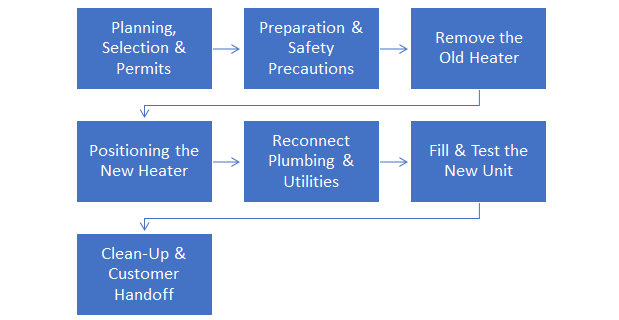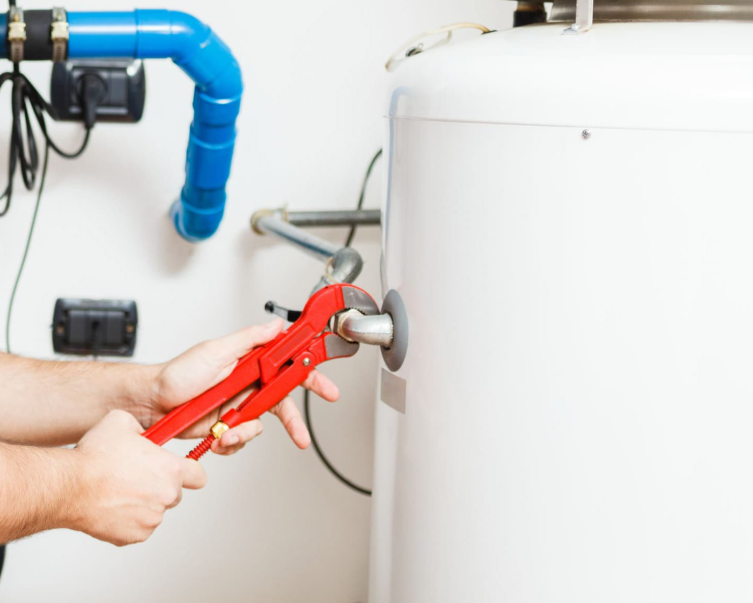Installing a new water heater is a big project. At Paradise Plumbing, we want homeowners in Southampton, Shirley, Quogue, and Easthampton to feel assured of the process.

Here is a step-by-step explanation of what we do, and what you can look forward to when installing your water heater.
Step 1: Planning, Selection & Permits
Assess Your Needs
-
- Traditional tank heaters hold between 40–80 gallons, good for families with typical usage.
- Tankless models provide hot water on demand, consistent pressure, and save space, great for modern homes.
Choose Energy Type
-
- Most Long Island homes use gas, but electric models are also popular.
- Tankless units can be gas or electric; installation requires evaluating your home’s gas line capacity and electric panel.
Obtain Permits
-
- Suffolk County, like many regions, requires permits for water heater installations.
- We handle all permit applications to ensure code compliance and pass inspections.
Step 2: Preparation & Safety Precautions
Turn Off Utilities
-
- Shut off the water supply at the main valve.
- For electric heaters, turn off the breaker; for gas units, close the gas valve.
Ventilation & Space Check
-
- Gas units need proper flue clearance.
- Electric units require a safe working area around the tank.
Tools & Materials
-
- We bring everything—including pipe wrenches, connectors, Teflon tape, pressure relief valves, drip pans, and flexible hoses—so you don’t have to worry about missing gear.
Step 3: Remove the Old Heater
Drain the Tank
-
- Connect the hose to drain valve and empty contents into a floor drain or bucket.
Disconnect Utilities
-
- For electric: disconnect wiring after verifying breaker is off.
- For gas: detach the gas line and inspect for damage.
- Disconnect hot and cold-water lines.
- Remove the expansion tank or sediment trap if installed.
Safely Remove the Unit
-
- Carefully roll out the old heater, using a dolly if needed.
Step 4: Positioning the New Heater
Proper Placement
-
- Ensure proper clearances, especially around vents for gas models.
- Add a drip pan under the new tank to protect flooring.
Install Expansion Tank (if required)
-
- Suffolk homes with backflow preventers or water softeners require expansion tanks to manage pressure changes.
Step 5: Reconnect Plumbing & Utilities
Water Lines
-
- Connect cold and hot water supply lines using Teflon tape for leak-free joints.
Pressure Relief Valve
-
- Install the T&P valve and a discharge pipe that leads to a safe location.
Gas or Electric Connections
-
- Gas units: connect gas line with flexible connector, then test with a soapy solution for leaks and do tightening if needed.
- Electric units: run a 240‑volt line, install a 30‑amp breaker, and connect using waterproof connectors.
Step 6: Fill & Test the New Unit
Fill the Tank
-
- Open cold-water input valve: let a hot faucet run until air is purged.
- Inspect all fittings and valves for leaks.
Start the Unit
-
- Gas: open gas valve, light pilot per manufacturer instructions, and observe flame.
- Electric: restore power via breaker, then set thermostat (typically 120°F for safety) and let water heat.
Final Check
-
- Monitor for leaks, verify pressure relief valve functions, and ensure thermostat is set correctly.
Professional Inspection
-
- Our final step is a thorough inspection: gas leak test, venting check, piping integrity, and continuity of electrical bond.
Step 7: Clean-Up & Customer Handoff
- Remove old water heater, recycle or responsibly dispose of it.
- Show you how to operate and adjust your new heater safely.
- Provide maintenance tips: annual drains to remove sediment, regular inspections, and expansion tank checks.
Full Video Guide
Why Choose Paradise Plumbing?
- Local Permitting: We handle all permitting and scheduling of inspections.
- Safety First: Full compliance with Suffolk County codes.
- Energy Tips: We recommend energy-efficient models with voice on rebates.
- Warranty & Support: We stand behind our work for years to come.
Conclusion
Hooking up a water heater isn’t merely a matter of installing a new tank. It’s a complete process that demands planning, professional competence, and adherence to regulations in your area. At Paradise Plumbing, we take charge of the whole ride: from choosing and permits to installation, testing, and ongoing support.
If your water heater is in trouble or on its last legs, contact Paradise Plumbing today for a free quote and consultation.

